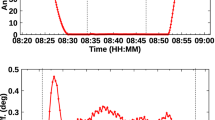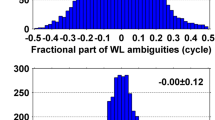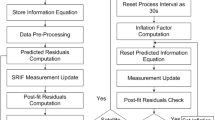Abstract
Orbital maneuvers are usually performed as needed for low earth orbiters to maintain a predefined trajectory or formation-flying configuration. To avoid unexpected discontinuities and to connect pre- and post-maneuver arcs with a minimal set of parameters, a maneuver has to be considered in the routine GPS-based orbit determinations. We propose a maneuver handling method in a reduced-dynamic scheme. With the proper thrust modeling and numerical integration strategy, the effects caused by orbital maneuver can be largely eliminated. The performance for both single-satellite precise orbit determination (POD) and inter-satellite precise baseline determination (PBD) is demonstrated using selected data sets from the Gravity Recovery and Climate Experiment (GRACE) mission. For the POD results, the orbit determination residuals indicate that the orbit with maneuver modeling is well fit to the GPS observations. The external orbit validation shows that the GRACE-B orbits obtained from our approach match the DLR reference orbits better than 3 cm (3D RMS), which is comparable to the result of the maneuver-free GRACE-A satellite. For the PBD results, on average 87 % of double-difference phase ambiguities can be resolved to integers and an RMS of the K-band ranging system residuals of better than 0.7 mm can be achieved, even though the orbital maneuver was performed on the spacecraft. Furthermore, the actual maneuver performance derived from the POD and PBD results provides rigorous feedback on the thruster system, which is not only beneficial for current maneuver assessment but also for future maneuver plans.











Similar content being viewed by others
References
Bertiger W, Desai S, Haines B et al (2010) Single receiver phase ambiguity resolution with GPS data. J Geod 84(5):327–337. doi:10.1007/s00190-010-0371-9
Beutler G, Jäggi A, Hugentobler U, Mervart L (2006) Efficient satellite orbit modelling using pseudo-stochastic parameters. J Geod 80(7):353–372. doi:10.1007/s00190-006-0072-6
Bock H, Jäggi A, Beutler G, Meyer U (2014) GOCE: precise orbit determination for the entire mission. J Geod 88(11):1047–1060. doi:10.1007/s00190-014-0742-8
D’Amico S, Ardaens JS, Larsson R (2012) Spaceborne autonomous formation-flying experiment on the PRISMA mission. J Guid Control Dyn 35(3):834–850. doi:10.2514/1.55638
D’Amico S, Ardaens JS, Flobio SD (2013) Autonomous formation flying based on GPS-PRISMA flight results. Acta Astronaut 82(1):69–79. doi:10.1016/j.actaastro.2012.04.033
Gill E, D’Amico S, Montenbruck O (2007) Autonomous formation flying for the PRISMA mission. J Spacecr Rockets 44(3):671–681. doi:10.2514/1.23015
Gu DF, Yi DY (2011) Reduced dynamic orbit determination using differenced phase in adjacent epochs for spaceborne dual-frequency GPS. Chin J Aeronaut 24(6):789–796. doi:10.1016/S1000-9361(11)60093-9
Haines H, Bar-Sever Y, Bertiger W, Desai S, Willis P (2004) One-centimeter orbit determination for Jason-1: new GPS-based strategies. Mar Geod 27:299–318. doi:10.1080/01490410490465300
Hatch R (1982) The synergism of GPS code and carrier measurements. In: Proceedings of the third international symposium on satellite Doppler positioning at physical sciences laboratory of New Mexico State University, vol 2, pp 1213–1231
Huang TY, Zhou QL (1993) Adams–Cowell integrator with a first sum. Chin Astron Astrophys 17(2):205–213. doi:10.1016/0275-1062(93)90071-V
Jäggi A, Hugentobler U, Beutler G (2006) Pseudo-stochastic orbit modeling techniques for low-earth orbiters. J Geod 80(1):47–60. doi:10.1007/s00190-006-0029-9
Jäggi A, Hugentobler U, Bock H, Beutler G (2007) Precise orbit determination for GEACE using undifferenced or doubly differenced GPS data. Adv Space Res 39(10):1612–1619. doi:10.1016/j.asr.2007.03.012
Jäggi A, Montenbruck O, Moon Y et al (2012) Inter-agency comparison of TanDEM-X baseline solutions. Adv Space Res 50(2):260–271. doi:10.1016/j.asr.2012.03.027
Krieger G, Moreira A, Fiedler H et al (2007) TanDEM-X: a satellite formation for high-resolution SAR interferometry. IEEE Trans Geosci Remote Sens 45(11):3317–3341. doi:10.1109/TGRS.2007.900693
Kroes R, Montenbruck O, Bertiger W, Visser P (2005) Precise GRACE baseline determination using GPS. GPS Solut 9:21–31. doi:10.1007/s10291-004-0123-5
Leick A, Rapoport L, Tatarnikov D (2015) GPS satellite surveying, 4th edn. Wiley, New York
Liu JH, Gu DF, Ju B et al (2014) Basic performance of BeiDou-2 navigation satellite system used in LEO satellites precise orbit determination. Chin J Aeronaut 27(5):1251–1258. doi:10.1016/j.cja.2014.03.006
Montenbruck O, Gill E (2000) Satellite orbits: models, methods and applications. Springer, Berlin
Montenbruck O, van Helleputte T, Kroes R, Gill E (2005) Reduced dynamic orbit determination using GPS code and carrier measurements. Aerosp Sci Technol 9(3):261–271. doi:10.1016/j.ast.2005.01.003
Montenbruck O, Kirschner M, D’Amico S, Bettadpur S (2006) E/I-vector separation for safe switching of the GRACE formation. Aerosp Sci Technol 10(7):628–635. doi:10.1016/j.ast.2006.04.001
Montenbruck O, Wermuth M, Kahle R (2011) GPS based relative navigation for the TanDEM-X mission—first flight results. Navigation 58(4):293–304. doi:10.1002/j.2161-4296.2011.tb02587.x
Moon Y, Koenig R, Wermuth M (2012) Operational precise baseline determination for TanDEM-X DEM processing. In: Proceedings of IEEE international geoscience and remote sensing symposium at Munich, July 22–27, pp 1633–1636. doi:10.1109/IGARSS.2012.6351215
Prince PJ, Dormand JR (1981) High order embedded Runge–Kutta formulae. J Comp Appl Math 7(1):67–75. doi:10.1016/0771-050X(81)90010-3
Tapley BD, Reigber C (2001) The GRACE mission: status and future plans. EOS Trans AGU 82(47), Fall Meet. Suppl. G41 C-02
Teunissen PJG (1995) The least-squares ambiguity decorrelation adjustment: a method for fast GPS integer ambiguity estimation. J Geod 70(1–2):65–82. doi:10.1007/BF00863419
Tu J, Gu DF, Wu Y, Yi DY (2012) Phase residual estimations for PCVs of spaceborne GPS receiver antenna and their impacts on precise orbit determination of GRACE satellites. Chin J Aeronaut 25(4):631–639. doi:10.1016/S1000-9361(11)60428-7
Visser P, van den Ijssel J (2003) Aiming at a 1-cm orbit for low earth orbiters: reduced-dynamic and kinematic precise orbit determination. Space Sci Rev 108(1–2):27–36. doi:10.1023/A:1026253328154
Wu SC, Yunck TP, Thornton CL (1991) Reduced-dynamic technique for precise orbit determination of low earth satellites. J Guidance Control Dyn 14(1):24–30. doi:10.2514/3.20600
Yoon YT, Montenbruck O, Kirschner M (2006) Precise maneuver calibration for remote sensing satellites. In: Proceedings of the 19th international symposium on space flight dynamics at Kanazawa, June 4–11, pp 607–612
Yoon YT, Eineder M, Yague-Martinez N, Montenbruck O (2009) TerraSAR-X precise trajectory estimation and quality assessment. IEEE Trans Geosci Remote Sens 47(6):1859–1868. doi:10.1109/TGRS.2008.2006983
Zelensky NP, Lemoine FG, Ziebart M et al (2010) DORIS/SLR POD modeling improvements for Jason-1 and Jason-2. Adv Space Res 46(12):1541–1558. doi:10.1016/j.asr.2010.05.008
Acknowledgments
This research was supported by the National Natural Science Foundation of China (Nos. 61370013 and 91438202). The authors would like to thank the Information Systems and Data Center (ISDC) and the German Space Operations Center (GSOC) for providing the science data and maneuver information of the GRACE mission. We also want to acknowledge Dr. Yoke Yoon for providing the information that helped the research and reviewing the paper. Last but not least, the comments and suggestions of the anonymous reviewers are greatly appreciated.
Author information
Authors and Affiliations
Corresponding author
Rights and permissions
About this article
Cite this article
Ju, B., Gu, D., Herring, T.A. et al. Precise orbit and baseline determination for maneuvering low earth orbiters. GPS Solut 21, 53–64 (2017). https://doi.org/10.1007/s10291-015-0505-x
Received:
Accepted:
Published:
Issue Date:
DOI: https://doi.org/10.1007/s10291-015-0505-x




